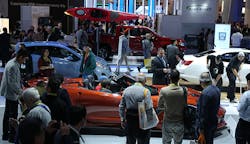Speaking in an energetic tone that seemed to mirror the rapid pace at which technology evolves in consumer electronics, Shawn Dubravac, the chief economist and senior director of research for the Consumer Technology Association (CTA), asked a rhetorical question to the members of the press gathered at CES Unveiled 2016 in New York this week.
“Does it make sense to put the Internet on your wrist?” he asked. He was referring to the proliferation of fitness bands for personal health monitoring and also to the changing mental approach that companies are taking with new technology. He said that the consumer electronics industry was no longer asking whether certain technologies were possible. Rather, it was asking itself about the role of digital information in shaping how people live and make decisions.
Dubravac’s analysis was part of a press conference at CES Unveiled, the annual preview of the main Consumer Electronics Show (CES), which will take place in the Las Vegas Convention Center from Jan. 6-9, 2016. The preview event, which is organized by the CTA (formerly the Consumer Electronics Association), offers a glimpse into what can be expected at the main CES. It also highlights some of the industry’s main priorities going forward.
Dubravac said that technology companies have entered a “massive experimental phase,” as the Internet of Things (IoT) causes them to evaluate “what it means to digitize [a] particular experience.” When talking about the industry, he occasionally cited his recent book, Digital Destiny: How the New Age of Data Will Transform the Way We Work, Live, and Communicate, which he wrote on behalf of the CTA earlier this year.
Having served as the research director for the CTA since 2005, Dubravac also presented his research at last year’s CES Unveiled press conference. He talked about the industry’s movement toward “digitizing our personal space,” converting everything that was once analog into a digital format—including ourselves. While that change is still taking place, the industry is now being forced to acknowledge the blurring of our physical and virtual identities, he said on Tuesday night.
CES Unveiled 2016 featured 36 companies, including 11 exhibitors positioned in Eureka Park, an area reserved exclusively for start-up companies. Although it was a far cry from the more than 3,600 exhibitors and 176,000 industry attendees at the International CES 2015, the event served as a kind of mock-up for the entire consumer electronics industry. Exhibits were devoted to audio devices, virtual reality, smart homes, robotics, health and fitness, data transmission, and televisions, among others.
Over the years, CES has grown into an event with an international reputation. It has such enormous attendance that it can serve as a barometer for the entire consumer electronics industry. Gary Shapiro, CTA president and CEO, said that wearable and personal health devices would continue to represent one of the fastest-growing segments of the event, with more than 150 health and fitness technology exhibitors at the upcoming CES.
For the last two years, Ultra HD 4K television has been a major focus of CES Unveiled, with the promise of new content dancing on the lips of the CTA. The enthusiasm surrounding the new television was tempered at this year's event, but the CTA made a point of acknowledging that Ultra HD 4K television manufacturers had already shipped more units than were expected for all of 2015.
Shapiro also cited unmanned systems and drone technology as areas of growth for the event. The CES will feature four times more exhibitors in the unmanned systems division than last year's event. Accordingly, robotics is also experiencing major growth, with 71% more exhibitors than CES 2015.
Karen Chupka, CTA secretary, added that the section of the Las Vegas Convention Center reserved for smart home and building automation exhibits would nearly double in size from last year. Meanwhile, gaming and virtual reality technologies will have 80% more exhibitors than last year.
Nine major automobile manufacturers and more than 100 automotive technology companies will also be represented at the event, a 25% increase in exhibits from last year, according to Shapiro. In October, it was announced that Mary T. Barra, CEO of General Motors, will present a keynote address at this year’s event on the convergence of automobiles and consumer electronics.
For Dubravac, the growth of the event into new industries is a perfect metaphor for the increasingly blurred line between our physical and virtual identities. This shift is being made possible by the rapid evolution of computing technology and sensing capabilities, he said. Increasingly, sensors are being used to measure and digitize our physical environment in a continuous way, what he called “ambient sensing.”
This shift was apparent all over the CES Unveiled showroom, as wearable technology and smart-home devices represented a large part of the products on display. The Oura Ring, for instance, monitors and evaluates health patterns using laboratory-grade sensors to measure sleep, activity, and heart rate. In addition, oximeters measure blood-volume pulse (BVP), a blood characteristic that is widely used to help treat chronic pain, anxiety, and stress.
Dubravac stressed that devices with more computing power and sensing capabilities are opening the door to a more intuitive interface with technology. The evolution of sensors in our consumer devices is resulting in the construction of a “digital self,” a digital counterpart to our physical selves that has virtual footprints and experiences. At the same time, machine learning algorithms are helping to better inform our experience with IoT devices.
Dubravac said that the next step in the evolutionary path for consumer electronics is sharing information between different devices and services. Personal health devices, for instance, could be used to measure body temperature and exchange that information with an intelligent thermostat, which could then adjust the temperature in the house accordingly.
Using sensors and computer processing to inform how we approach our lives also has its counterpart in industrial and commercial operations, Dubravac noted. He gave the example of an Airbus A380, which is equipped with a massive number of sensors that relay information about the status of the aircraft to pilots and engineers, who can use that information to respond to structural damages or other potential dangers.
The practice of analyzing large data sets to support industrial and commercial operations has been the theme of several other events this year, especially in the test and measurement and embedded computing industries. At NIWeek 2015, the annual conference on graphical system design, National Instruments talked about the acquisition, storage, access, and analysis of what it called "Big Analog Data." At ARM TechCon this week, embedded engineers were introduced to a wide range of development tools for the growing ARM IoT Device Platform.
While the amount of data that devices are gathering and processing is growing exponentially, both in consumer electronics and other industries, the CES will not be getting any larger this year. The CTA has placed an attendance cap of 150,000 to 170,000 on the event. The idea is to ease pressure on hotels and airlines serving the event, making it “a comfortable experience so that people can get around," Shapiro says.





